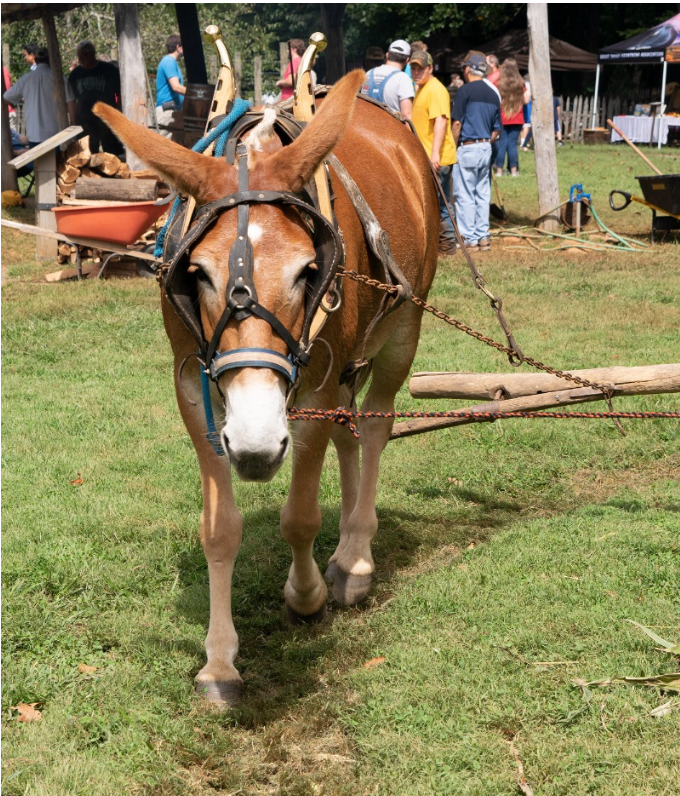
Sorghum-making demonstrations at Cades Cove Visitor Center and funded by Great Smoky Mountains Association take you back in time to the mountain farms that once populated the Smokies and their annual fall sorghum cane harvest. Demonstrations are free and open to the public. Upcoming dates are:
Cades Cove Sorghum Demonstration Dates
November 9, 10, 11 and 12 (Veteran’s Day)
November 16, 17 and 18
November 23, 24 and 25
GSMA exists in part to help preserve the unique history and culture of the Smokies. One way it does so is through funding sorghum-making demonstrations in the national park. Sorghum syrup is a distinct part of the Appalachian culture. Mountain inhabitants had a notoriously big sweet tooth, and for many, sorghum was the only sweetener available. (Rose Houk, Food & Recipes of the Smokies)
Visitors will find many nods to sorghum throughout the park’s eight visitor centres, including the 2018 seasonal coffee mug that honours the tradition and GSMA-published cookbooks containing delicious sorghum-based recipes.
Food & Recipes of the Smokies not only includes sweet sorghum recipes, it also dives into the history and importance of the crop. In the past, most mountain farmers had a cane patch. Seeds were planted in spring, and some farmers believed that sorghum cane planted in dark ground produced dark sorghum molasses, while that planted in light ground yielded light syrup. When the seed heads turned red and hard, it was time to harvest the cane. This needed to be done before the first frost, usually by late September or early October. (Rose Houk, Food & Recipes of the Smokies)
The plant’s leaves and seed heads were then stripped, and the cane was cut. It was taken without delay to a sorghum mill. Because molasses-making was something of a speciality, usually only a few people in any area had a mill, people with names like “Sugar John.” (Rose Houk, Food & Recipes of the Smokies)
To ensure the demonstrations are as realistic and historically accurate as possible, GSMA partners with experienced sorghum makers. Sherry and Mark Guenther, owners of Muddy Pond Sorghum in Monterey, Tenn., have been making their well-known trek to the Smokies each fall for 19 years. Their mules and old-timey tools draw crowds of onlookers who sometimes stand for hours, marvelling at the time and energy it took in years past to produce a family’s supply of sweetener.
“We bring our two mules and all equipment and supplies with us to set up our demonstration outside the Cades Cove Visitor Center,” Sherry said. “My husband feeds the sorghum cane into the more-than-100-years-old cane mill, while one of the mules is tied to the pole and walks around the mill. This squeezes the juice out of the sorghum cane.”
Mark then boils the freshly squeezed juice down on a wood-fired furnace until it becomes a thick, sweet sorghum syrup – the same syrup featured in Aunt Becky’s famous barbecue sauce, available at the visitor centre.
“GSMA sells our sorghum and barbecue sauce at a table near the live demonstration,” said Sherry. “I give visitors samples to taste and talk to them about this rich mountain tradition that many people – including people who lived in the Cove during the Great Depression – still practice today.”
Sorghum isn’t just a job for Sherry and Mark – it’s a passion. “We do these demonstrations to keep a dying art form alive,” Sherry said. “We enjoy teaching young people and children about a part of their history and helping older people relive a part of their childhood. Many of them remember their grandparents making sorghum syrup this way.”
The Guenther family’s sorghum is 100% pure sorghum with no additives and is made from Muddy Pond’s own sorghum cane planted each year. Learn more at MuddyPondSorghum.com.
Subscribe to get the latest posts sent to your email.
The Great Smokies Welcome Center is located on U.S. 321 in Townsend, TN, 2 miles from the west entrance to Great Smoky Mountains National Park. Visitors can get information about things to see and do in and around the national park and shop from a wide selection of books, gifts, and other Smokies merchandise. Daily, weekly, and annual parking tags for the national park are also available.